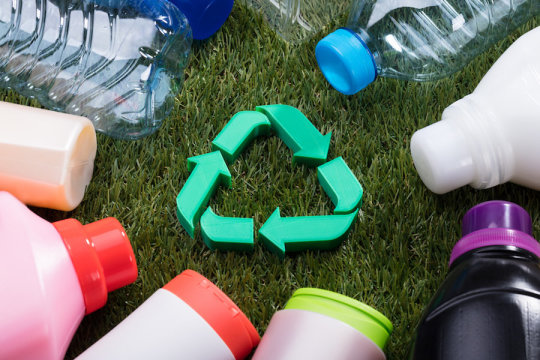[ad_1]
Recyclable plastics that contain ring-shaped polymers may be a key to developing sustainable synthetic materials. Despite some promising advances, researchers said, a full understanding of how to processes ring polymers into practical materials remains elusive. In a new study, researchers identified a mechanism called “threading” that takes place when a polymer is stretched — a behavior not witnessed before. This new insight may lead to new processing methods for sustainable polymer materials.
Most consumer plastics are blends of linear polymers. The concept of plastics made purely from ring polymers — molecules that form a closed ring — presents an enticing opportunity for sustainability, as shown by the Autonomous Materials Systems group at the Beckman Institute for Advanced Science and Technology. Once a single bond holding ring polymers together breaks, the entire molecule falls apart, leading to disintegration on demand. However, processing such polymers into practical materials remains a challenge, the researchers said.
A 2013 University of Illinois-led study showed that ring polymers could be broken with heat, but this comes at a price — the resulting plastics would likely become unstable and begin to break down prematurely.
In the new study, U. of I. researchers Charles Schroeder and Yuecheng (Peter) Zhou examine the flow dynamics of DNA-based ring and linear polymer solutions to tease out clues about how synthetic polymers interact during processing. Their findings are published in the journal Nature Communications.
“We lack a fundamental understanding of how ring polymers stretch and move in flow while navigating around other neighbor polymer chains. This work allowed us to probe these questions at a molecular level,” said Schroeder, a chemical and biomolecular engineering professor, Beckman Institute researcher and study co-author.
In Schroeder’s lab, the researchers stretch and squeeze polymers, causing them to flow and allowing direct observation of the behavior of individual molecules using single-molecule fluorescence microscopy.
“There is a fluctuation in the shape of the ring polymers and this depends on the concentration of linear polymers in the solution,” said Zhou, a graduate student, Beckman Institute researcher and lead author of the study. “We do not see this behavior in pure solutions of ring or linear polymers, so this tells us that something unique is happening in mixed solutions.”
Using a combination of direct single-molecule observations and physical measurements, the team concluded that the changes in shape of the ring polymers occur because linear molecules thread themselves through the ring molecules when stressed, causing the ring shape to fluctuate under fluid flow.
“We observed this behavior even when there is a very low concentration of linear polymers in the mix,” Zhou said. “This suggests that it only takes a very minute level of contamination to cause this phenomenon.”
This threading of linear polymers through ring polymers during stress is something that had been theorized before, using bulk-scale studies of the physical properties, but now it has been observed at the molecular scale, the researchers said.
“Bulk studies typically mask the importance of what is going on at the smaller scale,” Schroeder said.
How these observations will translate into further development of sustainable consumer plastics remains unclear, the researchers said. However, any insight into the fundamental molecular properties of mixed-polymer solutions is a step in the right direction.
“To make pure ring polymer plastics a reality, we need to understand both mixed and pure solutions at a fundamental level,” Schroeder said. “Once we can figure out how they work, then we can move on to synthesizing them and ultimately how to use them in sustainable consumer plastics.”
Former U. of I. graduate student Kai-Wen Hsiao, Kathryn E. Regan and Rae M. Robertson-Anderson, of the University of San Diego, and Dejie Kong and Gregory B. McKenna, of Texas Tech University, contributed to this study.
The National Science Foundation supported this research.
Story Source:
Materials provided by University of Illinois. Original written by Lois Yoksoulian. Note: Content may be edited for style and length.
[ad_2]















